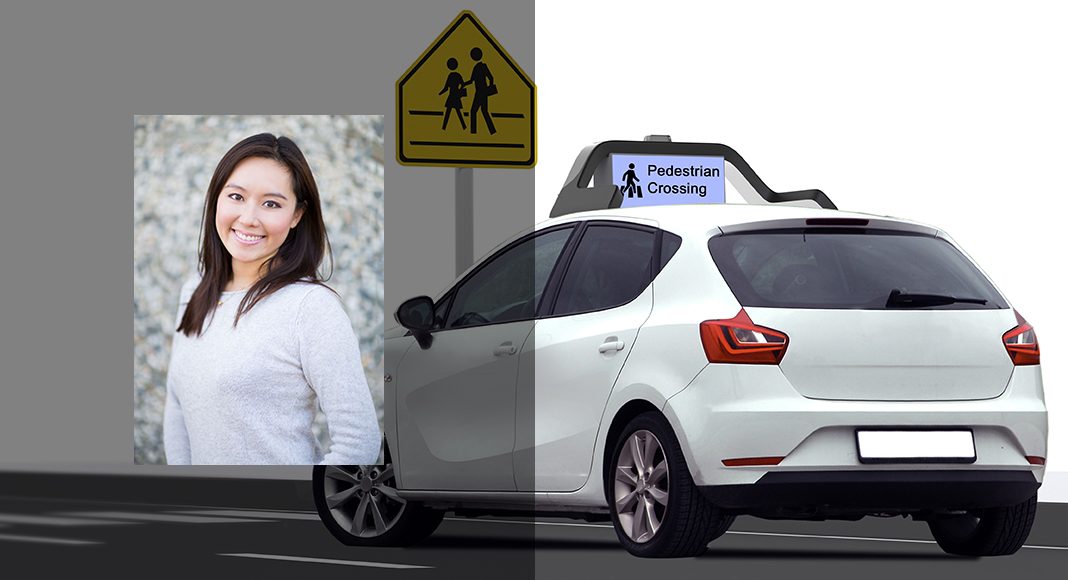Carol Reiley is Cofounder and President and drive.ai, an artificial intelligence self-driving car startup.
Carol is an NSF Graduate Research Fellow who researches strategies for improving human and robotic interaction.
Tell us about drive.ai
Drive.ai is a Silicon Valley start-up founded by former lab mates out of Stanford University’s Artificial Intelligence Lab. We are creating AI software (deep learning) for autonomous vehicles.
We know drive.ai has developed a retrokit for use with autonomous vehicles, but what exactly is the kit and what does it do?
We’re building a retrofit kit for business fleets that enables a car to drive itself. We’re using a full stack deep learning approach from perception, motion planning, decision making, to interacting with humans. Deep learning is this incredible form of machine learning that is most similar to the way the human brain processes sensor information, and we’re using it to build the brains of the self-driving car – which includes sensors, automotive grade computation, a roof-mounted exterior communication system, and an in-car interface, as well as the deep learning software to drive a car.
We think deep learning is the best-suited technology for self-driving cars, and that so far the industry has just scratched the surface of what it can do. We have trained our system to recognize objects as well as scenarios. These learned scenarios provide context to figure out the appropriate communication signal. Because of our amazing team and technology, we can now advance to be able to interact with the world. Our team consists of really amazing deep learning experts in the world, and we believe the work we’re doing will be crucial for the future of self-driving cars.
How can human-robot interaction (HRI) help cars to communicate with people and why is it so important that autonomous vehicles have the ability to communicate?
We consider communication a vital aspect of self-driving cars, in order to create transparency as to what these vehicles are doing and why. We believe this has been a largely ignored space so far, and consider it a fundamental aspect of our approach, both short- and long-term.
Cars need to indicate intention and the state that they’re in. Cars’ communication features, from blinkers to the horn, have not been reimagined in decades. There’s an incredible opportunity to improve this communication, especially in the case of self-driving cars where there is no human driver to indicate with hand gestures or facial signals. The horn, for example, is one of the worst designed features in the car today. It’s one sound/tone, and you can’t tell who it’s targeted at or what the intention is – it could be anything from a polite nudge to an angry exclamation.
How do you test HRI?
In the coming weeks we are planning to test a wide range of visual and audio messages for pedestrians and other people on the roads. Our test cases will likely involve written words, images and graphics, and an array of sounds.
How soon can we expect to see HRI on the roads?
Some companies are trying to deliver the first entirely autonomous car by 2020. At drive.ai, we’re looking to have our product on the road, which will guide a fully self-driving car in the next few months. You may be lucky enough to see the prototypes driving around now.
How different will the road environment look in 20 years’ time? Do you envisage roads to be safer places following the introduction of fully-autonomous vehicles, equipped with HRI?
The transportation industry is all going to change in 5-10 years.
The automobile industry has been stagnant, and we’re looking at cars differently. We have to. Every day, drivers and pedestrians are subject to a persisting danger: human error. Automobile accidents are the leading cause of death for young people in the United States; nearly 1.3 million people worldwide die in vehicle accidents every year, 90 per cent of which are caused by human error. Over 33,000 of these deaths are in the U.S. alone. That’s equivalent to a large passenger airplane crashing every single day. And someday, not too long from now, those deaths could be preventable. We started drive.ai because we believe there’s a real opportunity to make our roads, our commutes, and our families safer.
Our mission is to create self-driving cars that build trust through over-communication – communicating intentions not only to the people within the car, but the pedestrians and others around you. We absolutely believe that roads will be safer places with the introduction of fully-autonomous vehicles, and believe deep learning is key in doing that.





















